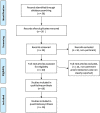Diagnosis of SARS-CoV-2 by RT-PCR Using Different Sample Sources: Review of the Literature
- PMID: 32865458
- PMCID: PMC7459180
- DOI: 10.1177/0145561320953231
Diagnosis of SARS-CoV-2 by RT-PCR Using Different Sample Sources: Review of the Literature
Abstract
Objective: The most widely used diagnostic technique for severe acute respiratory syndrome coronavirus 2 (SARS-CoV-2) infection is real-time reverse transcriptase-polymerase chain reaction (RT-PCR). It can be done on different samples: nasopharyngeal swabs (NPS) or oropharyngeal swabs (OPS), and self-collected saliva. However, negative findings do not rule out infection.
Methods: A review was conceived to discuss advantages and limitations of the available diagnostic modalities for nonserologic diagnosis of SARS-CoV-2 based on RT-PCR; the article also proposes some practical suggestions to improve diagnostic reliability.
Results: A total of 16 papers (corresponding to 452 patients) of the 56 initially identified were included. Most of the papers describe findings from different samples obtained in limited case series; comparative studies are missing.
Conclusions: Diagnostic accuracy of NPS and OPS is suboptimal and the risk of contaminated aerosol dispersal is not negligible. The SARS-CoV-2 RNA can be found in self-collected saliva specimens of many infected patients within 7 to 10 days after symptom onset. There is an urgent need for comparative trials to define the diagnostic modality of choice. Adequate education and training of health care personnel is mandatory.
Keywords: COVID-19; emergency; infection; nasopharynx; swab.
Conflict of interest statement
Figures



Similar articles
-
SARS-CoV-2 Detection in Fecal Sample from a Patient with Typical Findings of COVID-19 Pneumonia on CT but Negative to Multiple SARS-CoV-2 RT-PCR Tests on Oropharyngeal and Nasopharyngeal Swab Samples.Medicina (Kaunas). 2021 Mar 20;57(3):290. doi: 10.3390/medicina57030290. Medicina (Kaunas). 2021. PMID: 33804646 Free PMC article.
-
Adding saliva testing to oropharyngeal and deep nasal swab testing increases PCR detection of SARS-CoV-2 in primary care and children.Med J Aust. 2021 Sep 20;215(6):273-278. doi: 10.5694/mja2.51188. Epub 2021 Jul 20. Med J Aust. 2021. PMID: 34287935 Free PMC article.
-
Saliva is Comparable to Nasopharyngeal Swabs for Molecular Detection of SARS-CoV-2.Microbiol Spectr. 2021 Sep 3;9(1):e0016221. doi: 10.1128/Spectrum.00162-21. Epub 2021 Aug 18. Microbiol Spectr. 2021. PMID: 34406838 Free PMC article.
-
Diagnostic performance of different sampling approaches for SARS-CoV-2 RT-PCR testing: a systematic review and meta-analysis.Lancet Infect Dis. 2021 Sep;21(9):1233-1245. doi: 10.1016/S1473-3099(21)00146-8. Epub 2021 Apr 12. Lancet Infect Dis. 2021. PMID: 33857405 Free PMC article.
-
Screening for SARS-CoV-2 by RT-PCR: Saliva or nasopharyngeal swab? Rapid review and meta-analysis.PLoS One. 2021 Jun 10;16(6):e0253007. doi: 10.1371/journal.pone.0253007. eCollection 2021. PLoS One. 2021. PMID: 34111196 Free PMC article.
Cited by
-
Development and Validation of a Highly Sensitive Multiplex Immunoassay for SARS-CoV-2 Humoral Response Monitorization: A Study of the Antibody Response in COVID-19 Patients with Different Clinical Profiles during the First and Second Waves in Cadiz, Spain.Microorganisms. 2023 Dec 16;11(12):2997. doi: 10.3390/microorganisms11122997. Microorganisms. 2023. PMID: 38138141 Free PMC article.
-
Incidence and predictors of organ failure among COVID-19 hospitalized adult patients in Eastern Ethiopia. Hospital-based retrospective cohort study.BMC Infect Dis. 2022 Apr 28;22(1):412. doi: 10.1186/s12879-022-07402-6. BMC Infect Dis. 2022. PMID: 35484484 Free PMC article.
-
Nanomaterial-Based Biosensors for the Detection of COVID-19.Indian J Microbiol. 2025 Mar;65(1):120-136. doi: 10.1007/s12088-024-01336-0. Epub 2024 Jun 23. Indian J Microbiol. 2025. PMID: 40371045
-
Measuring the Possibility of Middle Ear Discharge for COVID-19 Test Material.Interdiscip Perspect Infect Dis. 2022 Apr 20;2022:7207846. doi: 10.1155/2022/7207846. eCollection 2022. Interdiscip Perspect Infect Dis. 2022. PMID: 35464252 Free PMC article. Review.
-
The association between vitamin D deficiency and the clinical outcomes of hospitalized COVID-19 patients.F1000Res. 2024 Feb 5;12:394. doi: 10.12688/f1000research.132214.4. eCollection 2023. F1000Res. 2024. PMID: 38434628 Free PMC article.
References
-
- World Health Organization. Coronavirus Disease 2019 (COVID-19). Situation Report-120. Updated June 10, 2020. Accessed June 11, 2020. https://www.who.int/docs/default-source/coronaviruse/situation-reports/2....
-
- Centers for Disease Control and Prevention. Interim Guidelines for Collecting, Handling, and Testing Clinical Specimens from Persons for Coronavirus Disease 2019 (COVID-19). Updated July 8, 2020. Accessed April 16, 2020. https://www.cdc.gov/coronavirus/2019-nCoV/lab/guidelines-clinical-specim...
-
- Lippi G, Simundic AM, Plebani M. Potential preanalytical and analytical vulnerabilities in the laboratory diagnosis of coronavirus disease 2019 (COVID-19). Clin Chem Lab Med. 2020;58(7):1070–1076. - PubMed
-
- Food and Drug Administration. New-York SARS-CoV-2. Real-Time RT-PCR Diagnostic Panel-February 29. Updated March 15, 2020. Accessed March 9, 2020. https://www.fda.gov/media/135662/download
Publication types
MeSH terms
Substances
LinkOut - more resources
Full Text Sources
Medical
Miscellaneous

